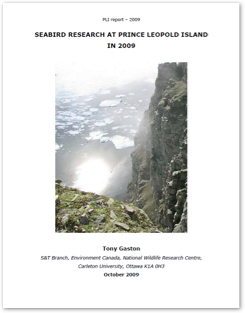Seabird Diets
Diets collected at High and Low Arctic colonies from adults (Thick-billed Murres, Northern Fulmars) and chicks (Thick-billed and Common Murres, Northern Gannets, Leach’s Storm-Petrels, Atlantic Puffins) during 2007-09 will extend existing time series data (Fig 2) and provide a baseline against which future change will be assessed. Dietary shifts across years and decades and between breeding and non-breeding seasons are compared within and across regions using historical data and stable (δ15N and δ13C) isotope analysis.
Recent Publications
Mallory, M. L., Gaston, A. J. and Gilchrist, H. G. (2009). Sources of breeding season mortality in Canadian Arctic seabirds. Arctic, 62 (3), 333-341. PDF
Gaston, T. (2009). Seabird Research at Prince Leopold Island in 2009. Canadian Wildlife Service Report. PDF
Gaston, T. (2008). Seabird Research at Prince Leopold Island in 2008. Canadian Wildlife Service Report. PDF
Elliott, K. H., Davoren, G.K. & Gaston, A.J. (2008). Sources of bias in observations of murre provisioning behavior. Journal of Field Ornithology, 79(3), 298-307. PDF
Elliott, K. H., Woo, K., Gaston, A.J., Benvenuti, S., Dall’Antonias, L. & Davoren, G.K. (2008). Seabird foraging behavior indicates prey type. Marine Ecology Progress Series, 354, 289-303. PDF
Montevecchi, W.A., Benvenuti, S., Garthe, S., Davoren, G.K., and Fifield, D. (accepted) Flexible foraging tactics by a large opportunistic seabird preying on forage and large pelagic fishes, Marine Ecology Progress Series. PDF
Montevecchi, W.A. (2007) Binary responses of Northern Gannets (Sula bassana) to changing food web and oceanographic conditions. Marine Ecology Progress Series, 352, 213-220. PDF
Smith, P.A. & Gaston, T. (2008). Seabird Research at Digges Island and Vicinity, 25 July - 17 August, 2008. Canadian Wildlife Service Report. PDF
Woo, K.J., Elliott, K. H., Davidson, M., Gaston, A.J. & Davoren, G.K. (2008). Individual specialization in diet by a generalist marine predator reflects specialization in foraging behaviour. Journal of Animal Ecology, 77, 1082-1091. PDF
Fig 2. Time series dietary data for High and Low Arctic regions. (A - High Arctic) Thick-billed Murres at Coats Is (1980-2007) exhibited a shift from ice-associated Arctic Cod to sub-Arctic capelin as conditions warmed, whereas (B - Low Arctic) Gannets at Funk Is (1977-2007) shifted from warm-water mackerel and saury to sub-Arctic capelin coincident with a cold water perturbation in 1991.






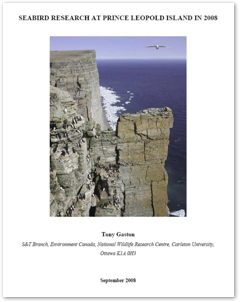
Predator Prey Interactions
Systematic ship-based surveys are being run in the foraging ranges of seabirds around Funk Is and Digges Is colonies 
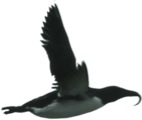
 during chick-rearing, 2007-08. Surveys will quantify the absolute biomass and distribution of marine animals (zooplankton, fish) using hydroacoustics and a remote operated vehicle (ROV). Simultaneous strip-transects will enumerate the density and distributions of seabirds and mammals. Integration of these data will assess dynamic interactions between predators and prey, and the selectivity of predators for certain prey species.
during chick-rearing, 2007-08. Surveys will quantify the absolute biomass and distribution of marine animals (zooplankton, fish) using hydroacoustics and a remote operated vehicle (ROV). Simultaneous strip-transects will enumerate the density and distributions of seabirds and mammals. Integration of these data will assess dynamic interactions between predators and prey, and the selectivity of predators for certain prey species.




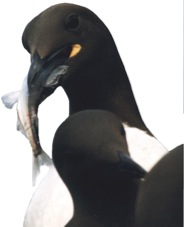




Recent Publications
Elliott, K.H. & Gaston, A.J. (2009). Accuracy of depth recorders. Waterbirds, 32(1), 183-191. PDF
Elliott, K.H., Woo, K. J. & Benvenuti, S. (2009). Do activity costs determine foraging tactics for an arctic seabird? Marine Biology, 156, 1809-1816. PDF
Elliott, K.H., Woo, K. J., Gaston, A.J., Benvenuti, S., Dall’Antonia, L. & Davoren, G.K. (2009). Central-place foraging in an arctic seabird provides evidence for Storer-Ashmole’s halo. The Auk, 126 (3), 613-625. PDF
Elliott, K.H., Bull, R.D., Gaston, A.J., & Davoren, G.K. (2009). Underwater and above-water search patterns of an Arctic seabird: reduced searching at small spatiotemporal scales. Behavioral Ecology Sociobiology. PDF
Burke, C.M. & Montevecchi, W.A. (2009). Fish and chicks: Forage fish and chick success in co-existing auks. Waterbirds, 31, 372-384. PDF
Elliott, K.H. & Gaston, A.J. (2008). Mass-length relationships for fishes delivered to nestling Thick-billed Murres Uria lomvia at Coats Island, 1981-2006. Marine Ornithology, 36, 25-34. PDF
Elliott, K.H., Davoren, G.K. & Gaston, A.J. (2008). Time allocation by a deep-diving bird reflects prey type and energy gain. Animal Behaviour, 75, 1301-1310. PDF
Elliott, K.H., Davoren, G.K. & Gaston, A.J. (2008). Increasing energy expenditure for a deep-diving bird alters time allocation during the dive cycle. Animal Behaviour, 75, 1311-1317. PDF
Hedd, A., Regular, P.M., Montevecchi, W.A., Buren, A.D., Burke, C.M. & Fifield, D.A. (2008, Accepted). Going deep: Common murres dive into frigid water for aggregated, persistent and slow-moving capelin. Marine Biology. PDF

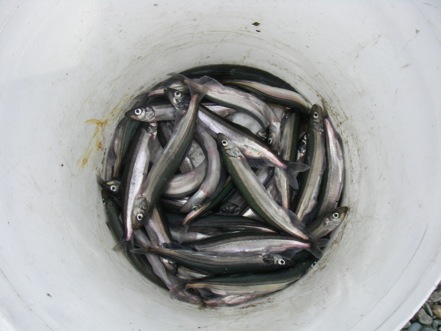

Capelin in a bucket, Beachy Cove Newfoundland - July 2008 (photo: J. Montevecchi)

Below are some images of stomach contents from seabirds collected at Arctic sites. We examine their stomach contents to study what the birds are eating.

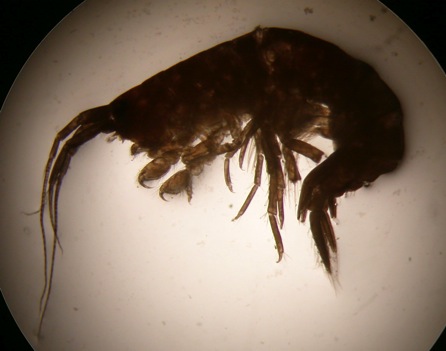

An amphipod from a TBMU stomach
(photo: J. Provencher)

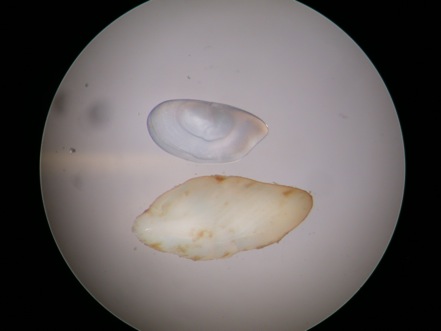

Otoliths found in the stomach contents of a TBMU. The larger is Arctic cod, the smaller is sandlance.
(photo: J. Provencher)
